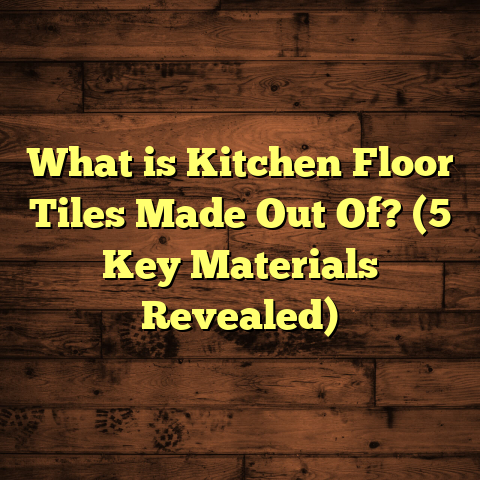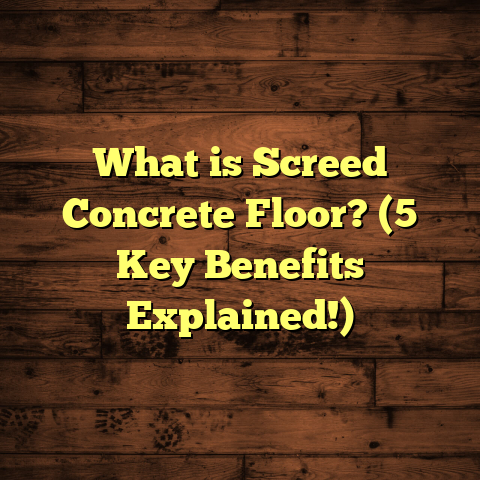What is River Rock Flooring Made Of? (5 Essential Components)
Have you ever walked into a home and felt instantly relaxed by the natural beauty of the floors? That’s the magic of river rock flooring. I remember the first time I stepped onto a river rock floor—it was like walking on a soft, natural path. The smooth stones underfoot created a soothing experience, making me wonder what goes into creating such a unique flooring option.
Let’s explore what river rock flooring is made of, diving into its five essential components. I’ll share some of my experiences in the field, along with insights and practical applications that could help you decide if this is the right choice for your space.
The Stones: The Heart of River Rock Flooring
The primary component of river rock flooring is, of course, the stones themselves. These stones are typically smooth and rounded, as they’ve been naturally weathered over time by water flow in rivers and streams. This natural process gives each stone its unique character and texture.
Types of Stones Used
1. River Pebbles:
These are the most common stones used in river rock flooring. They come in various sizes, shapes, and colors, allowing for a diverse aesthetic. The variety can range from small pebbles that provide a soft texture underfoot to larger stones that create a bolder look. Each pebble tells a story; some are polished and shiny, while others are more rustic.
2. Crushed Stone:
Sometimes, smaller crushed stones are mixed in with larger pebbles to fill gaps and provide stability. Crushed stone can help create a more uniform surface while retaining some of the natural charm of river rocks. I once worked on a project where we used a combination of polished river pebbles and crushed stone to create an inviting entryway that felt both elegant and grounded.
3. Decorative Stones:
Some installations may include decorative stones or glass beads for added visual interest. These can be used to create patterns or highlights within the flooring. During one installation, we used colored glass beads mixed with black river pebbles to create a stunning design that caught the eye immediately. It’s amazing how small details can transform a space!
The Adhesive: Binding It All Together
While the stones are beautiful on their own, they need an adhesive to hold them in place. The type of adhesive used can significantly impact the durability and longevity of your river rock floor.
Common Adhesives
1. Epoxy Resin:
Known for its strength and water resistance, epoxy is often the go-to choice for river rock installations. It creates a strong bond that can withstand moisture and heavy foot traffic. I’ve installed floors using epoxy in both indoor and outdoor settings, and it has consistently proven reliable.
2. Polyurethane:
This adhesive is another popular option due to its flexibility and ability to expand and contract with temperature changes. This can be particularly useful in areas with fluctuating climates. In one project, we used polyurethane adhesive in a sunroom that experienced extreme temperature variations during summer and winter, and it held up beautifully.
3. Cement-Based Adhesives:
While not as common as epoxy or polyurethane, some prefer cement-based adhesives for specific applications or when working with outdoor installations. I recall a project where we installed river rock flooring around a pool area using cement-based adhesive. It performed well under wet conditions while maintaining a natural look.
The Substrate: The Foundation
The substrate is the surface onto which the river rock is applied. Proper preparation of the substrate is crucial for ensuring that your river rock flooring remains stable and durable over time.
Types of Substrates
1. Concrete:
This is often the best choice for indoor installations, providing a sturdy base that supports the weight of the stones and adhesive. I usually recommend concrete for high-traffic areas since it helps distribute weight evenly across the surface.
2. Plywood:
For certain applications, such as in homes with wooden floors, plywood can be used as a substrate if it’s properly treated and reinforced. However, I always advise taking extra precautions when using plywood to ensure it doesn’t warp over time.
3. Cement Board:
In wet areas like bathrooms or kitchens, cement board provides excellent moisture resistance and stability. I’ve found that it works exceptionally well when paired with river rock flooring because it helps prevent damage from water exposure.
I’ve seen some homeowners make the mistake of skipping substrate preparation, which can lead to cracking or shifting stones later on. Trust me; investing time in this step pays off! Proper preparation not only enhances durability but also ensures that your beautiful river rock flooring stays intact for years to come.
The Grout: Filling In the Gaps
Grout plays an important role in river rock flooring by filling gaps between stones. It helps secure individual stones while also providing a finished look to the floor.
Types of Grout
1. Polymer-Modified Grout:
This type offers flexibility and can withstand slight movements in the flooring without cracking. I often recommend polymer-modified grout for areas prone to temperature changes or heavy use.
2. Epoxy Grout:
Known for its stain resistance and durability, epoxy grout is ideal for high-traffic areas or spaces prone to spills. I recently completed an installation in a family kitchen where we used epoxy grout; it held up well against spills from cooking without staining!
3. Cement-Based Grout:
While not as flexible or stain-resistant as epoxy, cement-based grout can work well in less demanding applications. It’s essential to seal cement-based grout to protect it from moisture and stains.
I once had a client who wanted to use colored grout to match their kitchen decor, creating a cohesive look that tied everything together beautifully. It’s amazing how something as simple as grout can transform the space! Choosing the right grout color can enhance the overall aesthetic of your river rock flooring while also providing functional benefits.
The Finish: Protecting Your Investment
Lastly, we come to the finish applied over the completed river rock floor. This layer protects against stains and wear while enhancing the natural beauty of the stones.
Types of Finishes
1. Sealants:
A good sealant will protect your floor from moisture damage and stains while also making it easier to clean. I’ve learned that sealing river rock flooring can add years to its life and maintain its appearance.
2. Polish:
For those wanting a shiny look, polishing can bring out the natural colors in the stones. I once polished a river rock floor that led to an incredible transformation—the colors popped so much!
3. Matte Finishes:
If you prefer a more subdued appearance, a matte finish can provide protection without adding gloss. I’ve found that matte finishes work well in rustic settings where homeowners want to maintain an earthy feel.
During one project, we used a high-quality sealant on an indoor river rock floor in a spa-like bathroom setting. The result was stunning! The stones glistened under soft lighting while remaining easy to maintain—a perfect combination.
Case Studies: Real-Life Applications
To further illustrate how each component plays into successful installations, let me share some case studies from my experiences.
Case Study 1: A Rustic Outdoor Patio
In one project, I was hired to create an outdoor patio using river rock flooring for a family who loved hosting summer barbecues. We chose medium-sized river pebbles in earthy tones that blended beautifully with their garden.
- Stones Used: A mix of smooth grey and brown pebbles.
- Adhesive: Epoxy resin was selected for its strength against outdoor conditions.
- Substrate: We laid down concrete for stability.
- Grout: We used polymer-modified grout to fill in gaps.
- Finish: A clear sealant was applied to protect against weathering.
The family loved their new space! They frequently commented on how comfortable it felt underfoot, even during hot summer days.
Case Study 2: A Spa-Like Bathroom Retreat
Another memorable project involved transforming a small bathroom into a serene retreat using river rock flooring. The homeowner wanted something calming yet stylish.
- Stones Used: We opted for smaller grey pebbles with hints of blue.
- Adhesive: Polyurethane was chosen for its flexibility.
- Substrate: Cement board was used due to moisture concerns.
- Grout: We went with epoxy grout for its stain resistance.
- Finish: A matte finish sealant was applied for protection.
The homeowner was thrilled with the outcome! They said it felt like stepping into a spa every time they entered the bathroom—the perfect escape!
Cost Considerations
Now that we’ve explored what river rock flooring is made of, let’s talk about cost estimation for your project. I’ve found that using tools like FloorTally has been incredibly helpful for understanding local material and labor rates.
With FloorTally, I can input specifics about my project—like square footage, desired materials, and even regional labor costs—to get precise estimates that help me budget effectively. It’s like having an expert consultant at my fingertips!
I remember one time when I was tasked with estimating a large installation for a client who wanted to cover their entire living room with river rock flooring. By using FloorTally, I could quickly generate an accurate cost estimate, which helped us align expectations and avoid surprises down the road.
Maintenance Tips for River Rock Flooring
Once you’ve installed your river rock flooring, proper maintenance becomes paramount to keep it looking fresh and new.
Regular Cleaning
- Sweep Regularly: To prevent dirt buildup, sweep or vacuum your floor regularly.
- Mop with Mild Detergent: Use warm water mixed with mild detergent for deeper cleaning—avoid harsh chemicals that could damage your finish.
- Spot Clean Stains Promptly: If spills occur, clean them up immediately to prevent staining or discoloration.
Periodic Sealing
Depending on foot traffic and exposure to moisture, sealing your river rock floor every few years can help maintain its beauty and integrity.
- Test Your Sealant Annually: Check if water beads on the surface; if not, consider resealing.
- Reapply Sealant as Needed: When reapplying sealant, ensure proper cleaning beforehand for optimal adhesion.
Addressing Damage
If you notice any shifting stones or cracks over time:
- Patch Loose Stones: Use appropriate adhesive to reattach any loose stones promptly.
- Repair Grout: If grout shows signs of wear or cracking, consider regrouting to prevent further damage.
Design Trends
River rock flooring isn’t just about functionality; it’s also about style! Here are some design trends I’ve noticed that can elevate your space:
Natural Aesthetics
More homeowners are leaning toward natural materials that bring warmth into their homes. River rock flooring perfectly embodies this trend with its earthy tones and textures.
Indoor-Outdoor Living
As people seek seamless transitions between indoor and outdoor spaces, river rock flooring fits beautifully in both environments—think patios leading into sunrooms or entryways blending with gardens.
Unique Patterns
Some homeowners are getting creative with patterns! Mixing different sizes or colors of stones can create stunning visuals—a technique I’ve used successfully in various projects.
Personal Reflections on River Rock Flooring
Reflecting on my journey as a contractor specializing in flooring, I cherish each opportunity to work with unique materials like river rocks. Every installation tells a story—whether it’s transforming a dull space into an inviting oasis or helping families create memories in their homes.
I recall one particular client who chose river rock for their children’s playroom. They loved how soft it felt underfoot while being easy to clean—a perfect combination for little ones running around!
Another memorable moment came when I received feedback from clients who had installed river rock flooring in their newly built home office. They expressed how calming it felt during long workdays—a testament to nature’s ability to soothe our busy minds.
Final Thoughts
So there you have it—the five essential components that make up river rock flooring. From the beautiful stones to the protective finish, each element plays a vital role in creating a stunning floor that can elevate any space.
If you’re considering this option for your home or project, think about how these components work together to create something unique and inviting. Whether it’s an outdoor patio or an indoor bathroom retreat, river rock flooring offers versatility and charm that few other materials can match.
Have you ever thought about using river rock flooring? What aspects excite you the most? Let’s chat!





